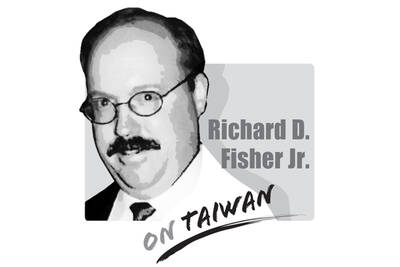The Ministry of Foreign Affairs on Tuesday said that it would continue to provide assistance to Palau for tourism and infrastructure, with the Pacific ally under pressure from China to break ties with Taiwan.
The importance to Taiwan, the US and other like-minded nations of good ties with Palau and keeping it free from Beijing’s influence is vital, as it is part of the second island chain, halfway between Guam and the Philippines — which are crucially important to strategic efforts to curtail Chinese expansionism in the Indo-Pacific region.
After Beijing built up Palau’s dependence on China for tourism, a vital component of its economy, it then stopped sending tourists to force Palau to switch recognition from Taipei to Beijing.
China Airlines has two direct flights per week between Taiwan and Palau, but, despite always being full, they cannot meet tourism needs.
Taipei should subsidize airlines to increase flights to Palau. It could partner with Japan and South Korea to help promote tourism there. If the flights are always full, there is clearly demand for travel to Palau, so promotional work should be straightforward.
There are other ways to help. For example, software companies could establish offices in Palau, and train and hire Palauan software engineers. The government could pay Taiwanese to work on infrastructure projects in Palau at no cost to the Palauan government.
The response of Palau’s leadership to Chinese pressure shows that money alone would not lure it into establishing ties with China, but it still has economic needs that must be met so Beijing cannot force Ngerulmud’s hand.
The US provides assistance through the Compact of Free Association, as well as through the Philippines-based office of the US Agency for International Development. Taiwan could cooperate with those agencies to help develop and fund infrastructure in Palau.
Taiwan must take the issue seriously, because Chinese economic and political influence go hand in hand, meaning Beijing might establish a police or military presence in Palau, as it has done in other countries.
The US is responsible for Palau’s defense and there has been talk of establishing a US military base there. If that happened, the navies of Taiwan and other countries could stop at ports there, assuming Palauans assented, which would also boost its economy.
Partners in the region have grown closer in the past few years due to shared concerns over Chinese expansionism. Australia in March announced plans to work with the US and the UK to upgrade its submarine fleet; the Philippines has allowed the US access to some of its bases; and on Sunday, the USS Ronald Reagan aircraft carrier docked in Da Nang, Vietnam.
Agence France-Presse on Monday said that the port call was only the third by a US aircraft carrier to the nation since the end of the Vietnam War.
“The visit gives that message that Vietnam is continuing to balance against China by improving its security relationship with the US and with other outside powers,” University of New South Wales Canberra researcher Nguyen The Phuong told AFP.
Boosting partnerships and exchanges to counter Chinese expansionism is vital, so ties with Palau are important and calls for assistance must not be taken lightly. The relationship must be protected as regional powers seek to demonstrate unity in the face of Chinese aggression.

On Sept. 3 in Tiananmen Square, the Chinese Communist Party (CCP) and the People’s Liberation Army (PLA) rolled out a parade of new weapons in PLA service that threaten Taiwan — some of that Taiwan is addressing with added and new military investments and some of which it cannot, having to rely on the initiative of allies like the United States. The CCP’s goal of replacing US leadership on the global stage was advanced by the military parade, but also by China hosting in Tianjin an August 31-Sept. 1 summit of the Shanghai Cooperation Organization (SCO), which since 2001 has specialized
In an article published by the Harvard Kennedy School, renowned historian of modern China Rana Mitter used a structured question-and-answer format to deepen the understanding of the relationship between Taiwan and China. Mitter highlights the differences between the repressive and authoritarian People’s Republic of China and the vibrant democracy that exists in Taiwan, saying that Taiwan and China “have had an interconnected relationship that has been both close and contentious at times.” However, his description of the history — before and after 1945 — contains significant flaws. First, he writes that “Taiwan was always broadly regarded by the imperial dynasties of
A large part of the discourse about Taiwan as a sovereign, independent nation has centered on conventions of international law and international agreements between outside powers — such as between the US, UK, Russia, the Republic of China (ROC) and Japan at the end of World War II, and between the US and the People’s Republic of China (PRC) since recognition of the PRC as the sole representative of China at the UN. Internationally, the narrative on the PRC and Taiwan has changed considerably since the days of the first term of former president Chen Shui-bian (陳水扁) of the Democratic
A report by the US-based Jamestown Foundation on Tuesday last week warned that China is operating illegal oil drilling inside Taiwan’s exclusive economic zone (EEZ) off the Taiwan-controlled Pratas Island (Dongsha, 東沙群島), marking a sharp escalation in Beijing’s “gray zone” tactics. The report said that, starting in July, state-owned China National Offshore Oil Corp installed 12 permanent or semi-permanent oil rig structures and dozens of associated ships deep inside Taiwan’s EEZ about 48km from the restricted waters of Pratas Island in the northeast of the South China Sea, islands that are home to a Taiwanese garrison. The rigs not only typify